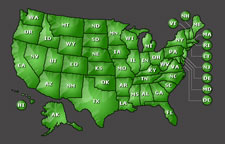Coast Mole (a.k.a. Pacific Mole, or Red-Footed Mole)(Scapanus orarius)
Coast moles… they’re odd-looking creatures, with almost invisible eyes, a long pointed nose, and proportionally massive forepaws. They use those forepaws to wreak their havoc on your lawn, creating networks of raised tunnels punctuated with dirt piles. To deal with them effectively, either on your own or when hiring a professional pest control company, arm yourself with basic information on their habits. These can be some difficult creatures to trap!
Basic Facts About Coast Moles
The coast mole is kind of a generalist as to where it lives: it’s happy in forested areas as well as prairies, coastal dunes, along streams, agricultural lands, and of course golf courses and suburban areas along the Pacific coast from southwestern British Columbia to central California. It’s about six inches long with dark gray fur.
In this case, it really is important to identify which mole you have. On the west coast, there’s one mole – the Townsend’s Mole, aka the snow mole – that is on the endangered species list in both the US and Canada. The Townsend mole is black, and has a hairless tail, whereas the (abundant) broad-footed and coast moles are brown to grayish-brown; the shrew mole is smaller than these other moles at only about 3-4 inches long. A pest animal control company can help you with identification and advise you on the wisest course of action.
Coast moles are sometimes mixed up with shrews; but shrews are smaller at 3-5 inches, where most moles are 5-7 inches long or more. Moles have shovel-like forepaws, while shrews’ feet are more mouselike.
Coast moles produce a litter of 2-5 pups between March and April. Any trapping should ideally occur before the pregnant female mole gives birth. In late summer, you’ll see more moles aboveground as juveniles leave the nest.
Dogs and cats, foxes, and owls are some of the animals that prey on coast moles. If poison baits are left out for the moles (and we don’t recommend this), there’s a risk that these predators can also be poisoned if they prey upon a mole that’s eaten the bait but not yet died. Most of these poisons do have antidotes, but why put your pet through that kind of trauma?
Most coast mole damage to turf occurs in winter, when moles soils are moist. Surface tunnels are often only used one time in search of food; after the food source is exhausted, the mole will abandon the tunnel and excavate a new one. They can undermine plant roots, indirectly causing damage or death. Rodents will use mole tunnels later on to attack plants from underground. Sometimes the damage caused by moles to lawns is mostly visual, and the problem can be solved by simply removing the molehills as they appear.
The Good Thing about Coast Moles
Yes, really -- the presence of coast moles does have an advantage. They have a voracious appetite for insects, including destructive insects such as cutworms and Japanese beetles; daily food consumption can equal 50-100% of the animal’s weight. They prefer earthworms, but will eat slugs, snails, centipedes, larval and adult insects, and ants.
Before You Start: Identify Your Suspects
Since coast moles, gophers and voles all leave runways in lawn and garden areas, they are often confused with each other. Because these pests are rarely seen, it makes more sense to base identification on the signs they leave behind. Proper pest identification is the first step in control.
Look closely at your piles of dirt. Coast mole mounds are volcano-like in appearance, while pocket gopher mounds are horseshoe-shaped. Voles, meanwhile, leave no mounds at all behind. Instead, voles construct well-defined, visible runways at or near the surface, about two inches wide. Vole runways result from the voles eating the grass blades, as well as from the constant traffic of numerous little feet over the same path.
Chemical Approaches & Home Remedies to Control Coast Moles
If you decide to try a chemical approach, be sure that you’re aiming at the right target. Going after lawn grubs and insects won’t impact mole activity much, given that the mole’s primary food is earthworms. In fact, many chemicals and home remedies (including castor oil derivatives and grub controls) are not only ineffective when dealing with moles, but they allow moles time to establish and become real problems.
All those glowing testimonials for these products can be explained by understanding moles’ behavior. On large properties, mole activity frequently moves from one part of the lawn to another. If disturbed, moles may temporarily leave an area but will usually return when you least expect it. Even without disturbance mole activity may last only a week or two in a particular area. This here-today, gone-tomorrow behavior is probably the root of most of the misconceptions that make some home remedies and pesticides appear credible.
Trapping Coast Moles
Traps, set either by the property owner or by a pest control company, are the best option. If you want to go it alone, realize that kill traps leave you with the problem of cleanup and proper disposal. Live traps leave the homeowner with the problem of how to deal with the live mole after it’s caught. In many states, animal relocation is prohibited (with good reason), so please check with your state natural resources or fish and wildlife department beforehand.
Coast moles will have their litters in early spring; trapping beforehand can eliminate pregnant females, nipping in the bud what could be a potentially bigger problem later on.
Where you place the trap is critical to your success in trapping. You’ll want to place your mole trap near active mole feeding tunnels. Here’s how to tell if a feeding tunnel is active:
Using your hand or a trowel, flatten sections of the moles’ raised ridges of soil. Mark these sections with something bright (perhaps some old ribbon that you can tie to a stick to make a little flag), so it will be easy to relocate them later. Check back within 12 to 24 hours to inspect the ridges you’ve flattened. If the ridges of soil are pushed back up, you’ll know that this is an active tunnel. This is where you’ll place your trap. We have a page dedicated to the different types of mole traps here
Cut out the turf over the active tunnel, and remove the soil right down to where the moles have beaten their path. While their vision is poor, however, moles are sensitive to the touch. This means you can't leave any loose soil in the path leading up to the trap, or the moles will detect it and back off. Set the trap according to directions and be sure to check your traps at least once a day.
If you decide you want to leave all this work to the pros, you want the animal control company to be completely knowledgeable of all relevant laws and regulations regarding trapping, removal, relocation of live animals, and whether any of the pest animals have protected or endangered status. You want them to hold all applicable state and local licenses, and they should be completely happy to show you documentation of this. Ditto for insurance. They should be experienced in dealing with the animal of concern. If you look to the left, there’s a list of local contacts for you to call for quick, efficient, and professional animal control services.

